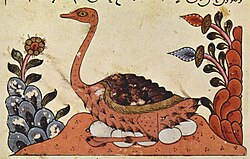Arabian ostrich
| Arabian ostrich | |
|---|---|
 |
|
| Arabian ostrich painting from The Book of Animals by al-Jahiz. Syria, 14th century. |
|
|
Extinct (1966)
|
|
| Scientific classification | |
| Kingdom: | Animalia |
| Phylum: | Chordata |
| Class: | Aves |
| Order: | Struthioniformes |
| Family: | Struthionidae |
| Genus: | Struthio |
| Species: | S. camelus |
| Subspecies: | S. c. syriacus |
| Trinomial name | |
|
Struthio camelus syriacus Rothschild, 1919 |
|
The Arabian ostrich or Syrian ostrich (Struthio camelus syriacus) is an extinct subspecies of the ostrich which lived on the Arabian Peninsula and in the Near East until the mid-20th century.
Its range seems to have been continuous in prehistoric times, but with the drying-up of the Arabian Peninsula, it disappeared from the inhospitable areas of the Arabian Desert, such as the Rub' al Khali. In historic times, the bird seems to have occurred in two discrete relict populations: a smaller one in the southeast of the Arabian Peninsula (8.8 feet tall) and a larger one in the area where today the borders of Saudi Arabia, Jordan, Iraq and Syria meet (10 feet tall). Towards the Sinai Peninsula, it probably intergraded with the North African subspecies camelus in earlier times. It looked exactly like that form; possibly, the females were of a slightly lighter coloration. The only certain way to distinguish camelus and syriacus was the smaller size of the latter, with only marginal overlap: the tarsus was 390–465 mm long in syriacus versus 450–530 mm in camelus.
The Arabian ostrich has long had a significant place in the culture of the region. An adult with 11 offspring is featured on the famous prehistoric "Graffiti Rock I" near Riyadh. In Mesopotamia, it was used as a sacrificial animal and featured in artwork, painted on cups and other objects made from ostrich eggs, traded as far as Etruria during the Neo-Assyrian period. In Tang China, an ostrich was a welcome exotic gift fit for an emperor: ostriches figure in the decoration of the Qianling Mausoleum, completed and closed in 706. The Jewish view of this bird was less favorable. The fact that the female ostrich may leave the nest unattended (because the eggs are too thick-shelled to be easily broken open by predators) is the reason why the bird is contrasted with the parental instinct of the stork in the Book of Job (Job 39:13-18.) This is also the reason why the Book of Lamentations (Lamentations 4:3) refers to the female ostrich as heartless. The Arabian ostrich is possibly among the birds forbidden to Jews as unclean under the kashrut in Leviticus (Leviticus 11:16), though the Israelites would just as likely have known the birds from the North African subspecies which was extant in the Nile Valley of Egypt at that time.
...
Wikipedia
